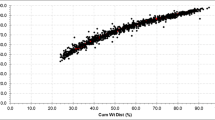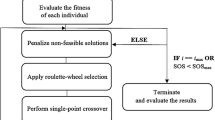ABSTRACT
After an initial grounding discussion, in which the linear mass-sectional population balance is described, and models for reducing the number of its parameters are discussed, this modeling approach is applied to a wide range of processes including batch mills, single-pass continuous mills, mills in series, mills with recycle, milling circuits including classification, and recycled-batch milling. The linearity of the model allows its straightforward inclusion in calculations for all of these processes. The sensitivity of the model to its inputs (order of rate kernel in size, fragment distribution) is explored for batch operations. Then, the effects of key continuous process design variables are explored including the (a) number of mill passes in pendulum milling (mills in series), (b) classifier properties in circuits with classification, and (c) ratio of feed tank-to-mill residence time in recycled-batch operations.
















Similar content being viewed by others
Abbreviations
- A :
-
upper triangular matrix of population balance model factors multiplied by m
- a ij :
-
elements of A
- a p,k :
-
positive root in recycled-batch expression for elements of J
- a m,k :
-
negative root in recycled-batch expression for elements of J
- b :
-
fragment number distribution
- b j :
-
jth moment of b in the variable z
- \( {b}_{k,j}^W \) :
-
fraction of mass from breaking size class j that lands in size class k
- b p,j :
-
positive root in recycled-batch expression for elements of K
- b m,j :
-
negative root in recycled-batch expression for elements of K
- C :
-
diagonal classifier matrix
- c km :
-
elements of C
- D :
-
diagonal matrix comprised of eigenvalues of A
- d ij :
-
elements of D
- d c :
-
scaled classifier cut size
- E :
-
matrix comprised of eigenvectors of A
- e im :
-
elements of E
- \( {\tilde{e}}_{im} \) :
-
elements of the inverse of E (E-1)
- f :
-
probability density, e.g., f(t) for residence time distribution or f(z) for fragment distribution
- f¯ :
-
Laplace transform of f
- g :
-
probability density for particle mass distribution
- I :
-
identity matrix
- J :
-
matrix embodying solution to set of decoupled ODEs
- j km :
-
elements of J
- K :
-
matrix embodying solution for feed tank dynamics
- k jn :
-
elements of K
- L :
-
matrix embodying solution in Laplace domain
- l ij :
-
elements of L
- M :
-
mass holdup in mill
- m :
-
vector of size class mass occupancies
- m o :
-
initial or feed value of m
- m k :
-
mass in kth size class
- n :
-
exponent in classifier fractional mass collection efficiency
- p :
-
number of fragments produced in breaking a particle
- q :
-
parameter of the beta fragment distribution
- r :
-
parameter of the beta fragment distribution
- R :
-
matrix embodying solution to mill withrecycle
- r km :
-
elements of R
- RR :
-
recycle ratio
- S br, j :
-
breakage rate constant for jth size class
- Sbr o :
-
size-independent part of breakage rate constant
- s :
-
independent variable in Laplace domain
- t :
-
time
- V :
-
particle volume
- V c :
-
classifier “cut” particle volume
- V¯ k :
-
arithmetic average particle volume of kth size class
- V k :
-
upper-bound particle volume of kth size class
- V o :
-
particle volume for scaling, often the sectionalization upper bound
- V w :
-
mass mean particle volume
- Vw o :
-
initial mass mean particle volume
- W j :
-
mass flow rate
- w :
-
particle volume scaled by mass mean particle volume
- y :
-
vector of linear combinations of elements of m that decouples system of ODEs
- z :
-
ratio of fragment-to-parent particle volume
- α :
-
sectionalization parameter in Vk/Vk − 1 = 2α
- B:
-
beta function: \( B\left(q,r\right)={\int}_0^1{z}^{q-1}{\left(1-z\right)}^{r-1} dz \)
- B inc :
-
incomplete beta function: \( {B}_{\mathrm{inc}}\left(q,,;r;;;x\right)={\int}_0^1{z}^{q-1}{\left(1-z\right)}^{r-1} dz \)
- δ ij :
-
Kronecker delta
- ƞ:
-
order of breakage rate in particle volume
- θ M :
-
scaled time for mill in recycled-batch mode
- τ :
-
mean residence time
- τ M :
-
mean residence time of mill
- τ o :
-
mean residence time without recycle
- τ T :
-
mean residence time of feed tank
- φ :
-
parent particle volume
- o :
-
system feed
- f :
-
mill feed
- r :
-
recycle
- d :
-
mill discharge
- p :
-
milled product
REFERENCES
Seibert KD, Collins PC, Luciani CV, Fisher ES. Milling operations in the pharmaceutical industry. In: am Ende DJ, am Ende MT, editors. Chemical engineering in the pharmaceutical industry: active pharmaceutical ingredients. 2nd ed. Hoboken: John Wiley & Sons; 2019. p. 861–80.
Bilgili E, Capece M, Afolabi A. Modeling of milling processes via DEM, PBM, and microhydrodynamics. In: Pandey P, Bharadwaj R, editors. Predictive modeling of pharmaceutical unit operations. Amsterdam: Elsevier; 2016. p. 159–203.
Von Bass L. Zur theorie der mahlvorgänge. Z Angew Math Phys. 1954;5:283–92.
Austin LG. A review: introduction to the mathematical description of grinding as a rate process. Powder Technol. 1971;5:1–17.
Bilgili E, Scarlett B. Population balance modeling of non-linear effects in milling processes. Powder Technol. 2005;153:59–71.
Bilgili E, Yepes J, Scarlet B. Formulation of a non-linear framework for population balance modeling of batch grinding: beyond first-order kinetics. Chem Eng Sci. 2006;61:33–44.
Herbst JA, Fuerstenau DW. Scale-up procedure for continuous grinding mill design using population balance models. Int J Miner Process. 1980;7:1–31.
Vogel L, Peukert W. Breakage behavior of different materials—construction of a mastercurve for the breakage probability. Powder Technol. 2003;129:101–10.
Ghadiri M, Zhang Z. Impact attrition of particulate solids: part 1: a theoretical model for chipping. Chem Eng Sci. 2002;57:3659–69.
Zhang Z, Ghadiri M. Impact attrition of particulate solids: part 2: experimental work. Chem Eng Sci. 2002;57:3671–86.
Moreno-Atanasio R, Ghadiri M. Mechanistic analysis and computer simulation of impact breakage of agglomerates: effect of surface energy. Chem Eng Sci. 2006;61:2476–81.
Hill PJ, Ng KM. Statistics of multiple particle breakage. AICHE J. 1996;42:1600–11.
Diemer RB, Olson JH. A moment methodology for coagulation and breakage problems: part 3 –generalized daughter distribution functions. Chem Eng Sci. 2002;57:4187–98.
Peterson TW. Similarity solutions for the population balance equation describing particle fragmentation. Aerosol Sci Technol. 1986;5:93–101.
Austin L, Shoji K, Bhatia V, Jindal V, Savage K. Some results on the description of size reduction as a rate process in various mills. Ind Eng Chem Res. 1976;15:187–96.
Capece M, Bilgili E, Davé R. Insight into first-order breakage kinetics using a particle-scale breakage rate constant. Chem Eng Sci. 2014;117:318–30.
Capece M, Bilgili E, Davé R. Identification of the breakage rate and distribution parameters in a non-linear population balance model for batch milling. Powder Technol. 2011;208:195–204.
Author information
Authors and Affiliations
Corresponding author
Additional information
Guest Editors: Alexander Russell and Maxx Capece
Publisher’s Note
Springer Nature remains neutral with regard to jurisdictional claims in published maps and institutional affiliations.
APPENDIX
APPENDIX
The following fills in the gaps in developing the solution for the time-dependent mill discharge size distribution in getting from Eq. 46 to Eq. 47. Eq. 46 can be simplified to:
Multiplying by the inverse of the eigenvalue matrix (i.e., by E−1) and collecting terms leads to:
We define an inverse diagonal matrix via:
Therefore:
This is then utilized in Eq. 47.
In a similar vein, the expression below fills in the gaps between substituting the time-dependent mill discharge size distribution into the mill feed equation, transforming to the Laplace domain, and rearranging to formally invert to the time domain with the final line being the result given in Eq. 49.
Rights and permissions
About this article
Cite this article
Diemer, R.B. Applications of the Linear Mass-Sectional Breakage Population Balance to Various Milling Process Configurations. AAPS PharmSciTech 22, 86 (2021). https://doi.org/10.1208/s12249-020-01834-6
Received:
Accepted:
Published:
DOI: https://doi.org/10.1208/s12249-020-01834-6




